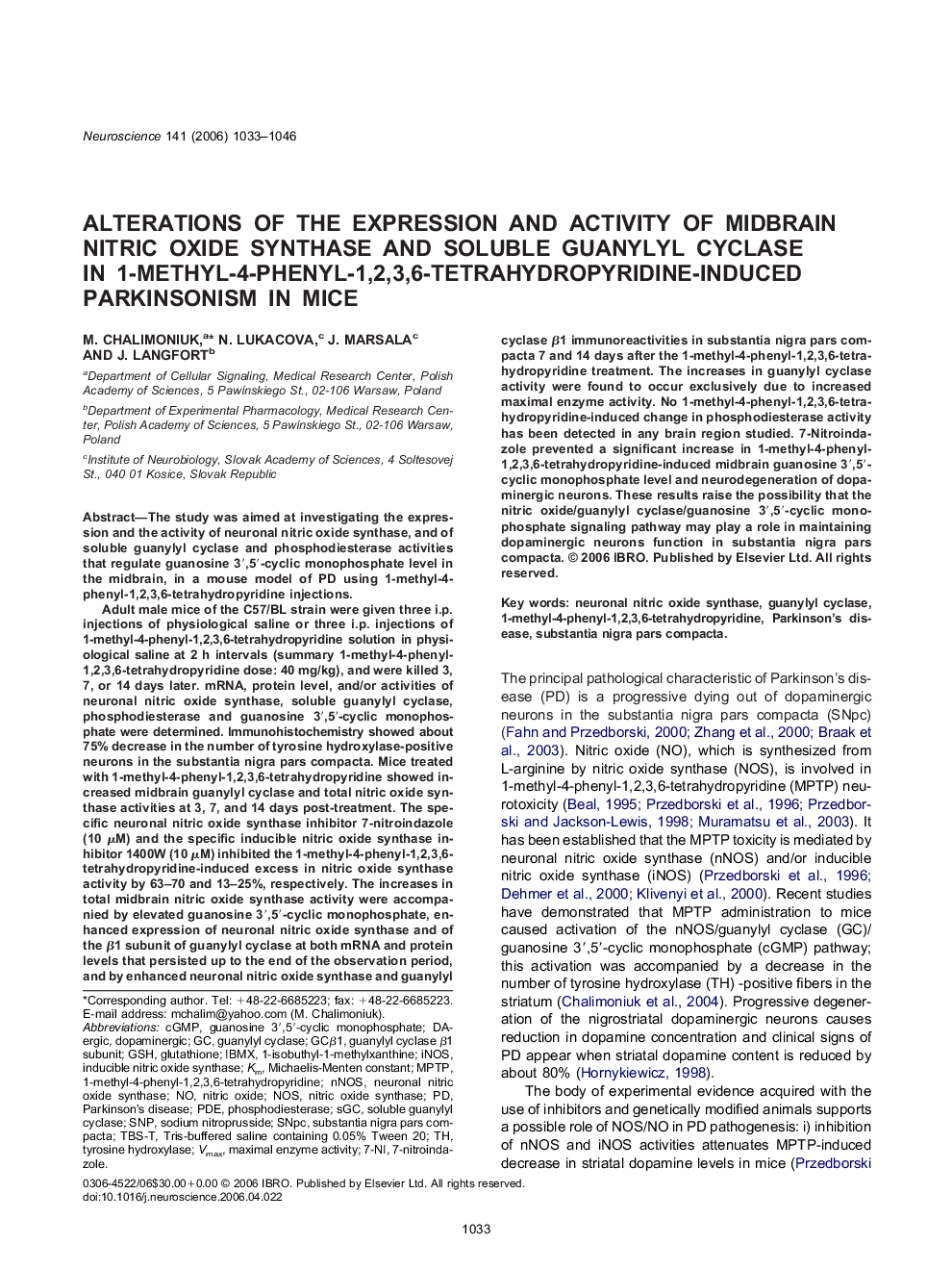| Article ID | Journal | Published Year | Pages | File Type |
|---|---|---|---|---|
| 4342793 | Neuroscience | 2006 | 14 Pages |
The study was aimed at investigating the expression and the activity of neuronal nitric oxide synthase, and of soluble guanylyl cyclase and phosphodiesterase activities that regulate guanosine 3′,5′-cyclic monophosphate level in the midbrain, in a mouse model of PD using 1-methyl-4-phenyl-1,2,3,6-tetrahydropyridine injections.Adult male mice of the C57/BL strain were given three i.p. injections of physiological saline or three i.p. injections of 1-methyl-4-phenyl-1,2,3,6-tetrahydropyridine solution in physiological saline at 2 h intervals (summary 1-methyl-4-phenyl-1,2,3,6-tetrahydropyridine dose: 40 mg/kg), and were killed 3, 7, or 14 days later. mRNA, protein level, and/or activities of neuronal nitric oxide synthase, soluble guanylyl cyclase, phosphodiesterase and guanosine 3′,5′-cyclic monophosphate were determined. Immunohistochemistry showed about 75% decrease in the number of tyrosine hydroxylase-positive neurons in the substantia nigra pars compacta. Mice treated with 1-methyl-4-phenyl-1,2,3,6-tetrahydropyridine showed increased midbrain guanylyl cyclase and total nitric oxide synthase activities at 3, 7, and 14 days post-treatment. The specific neuronal nitric oxide synthase inhibitor 7-nitroindazole (10 μM) and the specific inducible nitric oxide synthase inhibitor 1400W (10 μM) inhibited the 1-methyl-4-phenyl-1,2,3,6-tetrahydropyridine-induced excess in nitric oxide synthase activity by 63–70 and 13–25%, respectively. The increases in total midbrain nitric oxide synthase activity were accompanied by elevated guanosine 3′,5′-cyclic monophosphate, enhanced expression of neuronal nitric oxide synthase and of the β1 subunit of guanylyl cyclase at both mRNA and protein levels that persisted up to the end of the observation period, and by enhanced neuronal nitric oxide synthase and guanylyl cyclase β1 immunoreactivities in substantia nigra pars compacta 7 and 14 days after the 1-methyl-4-phenyl-1,2,3,6-tetrahydropyridine treatment. The increases in guanylyl cyclase activity were found to occur exclusively due to increased maximal enzyme activity. No 1-methyl-4-phenyl-1,2,3,6-tetrahydropyridine-induced change in phosphodiesterase activity has been detected in any brain region studied. 7-Nitroindazole prevented a significant increase in 1-methyl-4-phenyl-1,2,3,6-tetrahydropyridine-induced midbrain guanosine 3′,5′-cyclic monophosphate level and neurodegeneration of dopaminergic neurons. These results raise the possibility that the nitric oxide/guanylyl cyclase/guanosine 3′,5′-cyclic monophosphate signaling pathway may play a role in maintaining dopaminergic neurons function in substantia nigra pars compacta.
